Hundreds of small mounds with holes, each the diameter of a pencil, surrounded me. Above them zigging, dark, smallish bees traced incomprehensible patterns through the air: cellophane bees.
Nature
 On the Wing: Love, Hate, and House Sparrows
On the Wing: Love, Hate, and House SparrowsOn the East End, we hear a lot about invasive species in the plant world, but the house sparrow was one of the original invasive species. House sparrows are bullies. They fight over dirt baths. They are nonmigratory, colonize habitat, and then profusely breed. When native migratory birds return to nest in the spring, these pugnacious birds force them away.
 A Bad Year for Bald Eagles and Their Nests
A Bad Year for Bald Eagles and Their NestsIn March, a dead bald eagle was found below a nest in Montauk County Park, a victim of rodenticide. Another nest at the edge of Georgica Pond in East Hampton was lost when the pitch pine it was built in was removed because it had been killed by a southern pine beetle infestation.
 Love the Whales? Thank the Bunker
Love the Whales? Thank the BunkerIf 2023 was the year of the shark on the South Fork, with multiple sightings leading to frequent temporary beach closings, 2024 seems to be the year of the whale. Last week, for the first time ever, “we had to pull people out of the water to let a whale pass. It was only 20 feet offshore,” said Drew Smith, the head lifeguard for East Hampton Village.
 Sagaponack Cedar Withstands Ravages of Time
Sagaponack Cedar Withstands Ravages of TimeIn the middle of a swamp in Sagaponack is a remnant of colonial history, a stand of Atlantic white cedar trees, as important and ubiquitous 300 years ago as iPhones are now. In fact, what is likely the largest Atlantic white cedar tree in the state, and certainly the largest on Long Island, grows there completely unheralded.
 On the Wing: Birding With the Dead
On the Wing: Birding With the DeadSummer is perhaps the worst time of year to bird. You’re birding but you’re not really birding. Leave your binoculars at home. Leave your iPhone and Merlin app in the car. This is not for that. Instead, stroll through the cemetery, grow thoughtful, and let the birds, many of which will live only a few years, be your soundtrack.
 Montauk Beaver Meets Its End on Highway
Montauk Beaver Meets Its End on HighwayA beaver that likely arrived at Hither Hills State Park in the ocean surf last April and then built a lodge in a secluded part of Fresh Pond in Hither Woods was found dead on the side of Montauk Highway Tuesday morning.
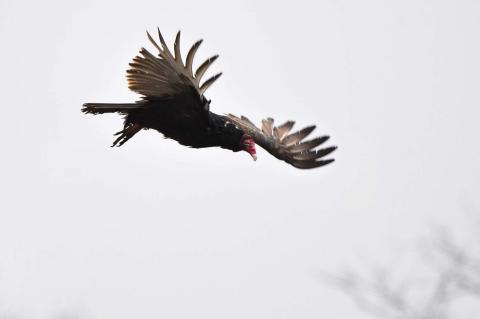 On the Wing: A Majestic Dump Dweller
On the Wing: A Majestic Dump DwellerIf given the opportunity, a turkey vulture would eat you, your kids, and your little dog, too. Other bird species may be struggling, but the turkey vulture is doing just fine eating dead things. Yes, with increasing signs that the end is nigh, the turkey vulture is a strong candidate for Bird of 2024.
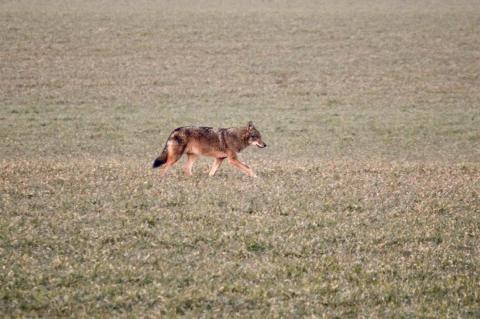 Coyotes Make Further Inroads on Long Island
Coyotes Make Further Inroads on Long IslandCoyote sightings on the North Fork this autumn and a month ago in Bridgehampton are not surprising to those who study this wide-ranging mammal. Coyotes have never bred in Suffolk County, but with one-off sightings increasing in frequency, the question isn’t if they will breed here but when.
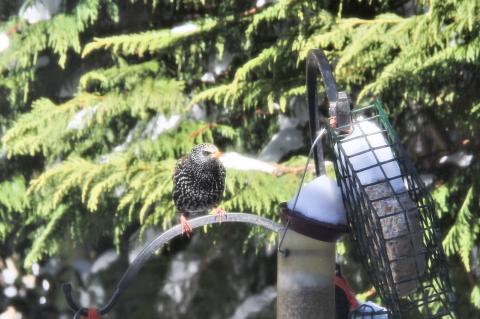 A Bird Count for Everyone
A Bird Count for EveryoneNovember is the month when a dedicated group of citizen scientists begin to count birds as part of Project FeederWatch, a Cornell Lab of Ornithology program now in its 37th year. It’s simple. Go to feederwatch.org, pay $18, learn how to report your birds, get some swag that will help you make proper identifications, and you’re on the team.
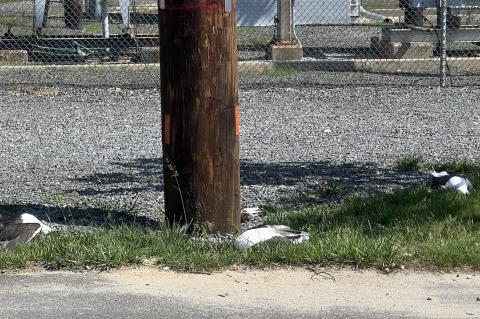 A Spate of Dead Birds In Montauk
A Spate of Dead Birds In MontaukIndustrial Road, because of its geography and development, has long been a dangerous area for birds. One woman has found 11 dead gulls near the PSEG electrical substation there since late June, and it's not just gulls that are dying.
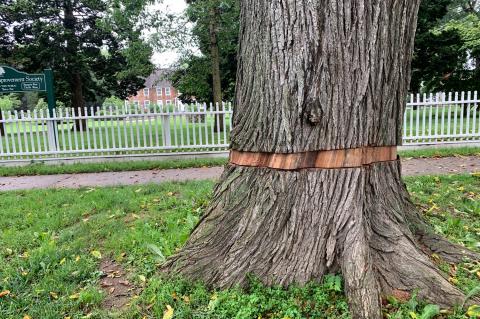 Another East Hampton Village Elm Succumbs
Another East Hampton Village Elm SuccumbsIf you’ve walked by the Ladies Village Improvement Society headquarters on East Hampton Main Street or waited at the Hampton Jitney stop in front of it, you may have noticed an elm with its bark cut away in a neat strip around the tree’s circumference. “Won’t that kill the tree?” one curious walker asked The Star two weeks ago after spotting it. The answer is yes, but it may also help save others nearby from Dutch elm disease
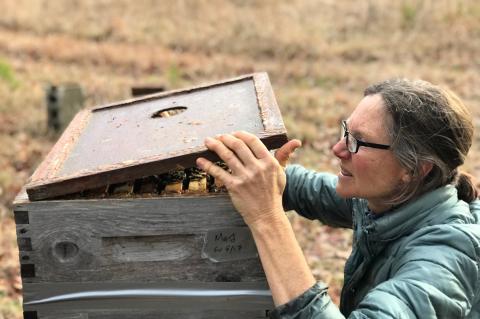 Bees Also Have Needs in Winter
Bees Also Have Needs in WinterWhile the bees are mostly hive-bound and slowed by the cold of winter, it’s not a time of rest for a beekeeper.
 On the Wing: We Should Call It the Zebra Bird
On the Wing: We Should Call It the Zebra BirdYou don’t need to go deep into the woods to find a red-bellied woodpecker, but if you're looking for a distinctive red belly, you won't find it. Instead, its head is red, which explains why people often misidentify it as the red-headed woodpecker, which hardly shows up on Long Island.
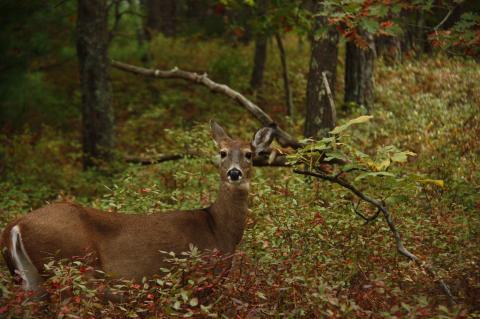 Studying the Dining Habits of Deer
Studying the Dining Habits of DeerIn an attempt to get a handle on the impacts of the region's outsize deer population, East Hampton Town established a new fenced-in deer “exclosure” in mid-October in Northwest Woods. The idea of it is pretty simple: Deer are restricted from feasting inside the fence, so that the plant life inside “can be compared to vegetation outside of it to determine the impact deer 'browse' is having.”
 On the Wing: Turkeys, Turkeys, Everywhere
On the Wing: Turkeys, Turkeys, EverywhereIt’s hard to decouple the turkey from Thanksgiving, but long before we paired turkeys with mashed potatoes and stuffing and turned them into a national symbol, they were going about their business, hanging out in gangs, flipping leaves, and browsing the ground for nuts.
 An Unhealthy Obsession With Leaf Removal
An Unhealthy Obsession With Leaf RemovalOn the South Fork, it seems the moment a leaf falls to the ground it becomes a nuisance to be blown, corralled, and carted to a landfill. But leaving at least some of those leaves be can be healthy for your lawn and your other plantings.
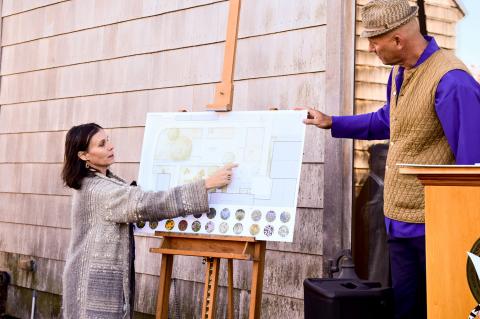 Pollinator Garden Unveiled at Town Hall
Pollinator Garden Unveiled at Town Hall“There’s trouble in paradise,” Gail Pellett of ChangeHampton said outside East Hampton Town Hall last Thursday, where a group of elected officials and residents had gathered for a ceremonial groundbreaking for a community pollinator garden that will extend a pollinator pathway that includes another garden and a wildflower meadow in progress on the campus.
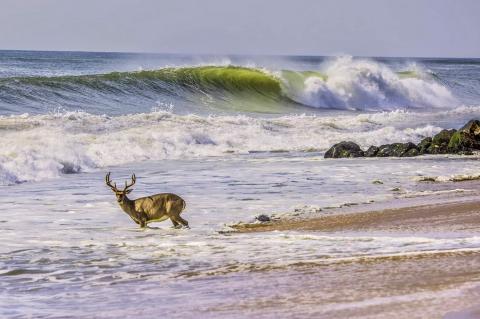 Bluetongue Virus Hits Deer Here
Bluetongue Virus Hits Deer HereBluetongue, a serious virus, has been detected for the first time in New York State deer. A cousin of epizootic hemorrhagic disease, it is spread by the bite from a midge, or no-see-um, and incubates in a deer for seven days before the animal begins to show symptoms. There is no treatment for the virus, which typically kills an adult deer within 36 hours.
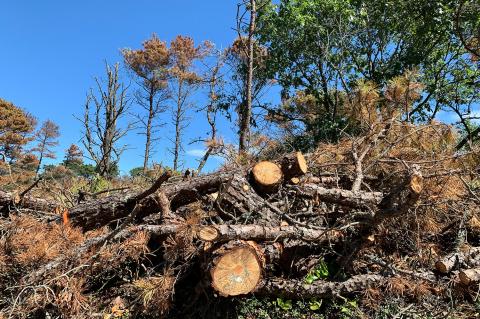 Pine Beetles Wreaking Havoc on Napeague Forest
Pine Beetles Wreaking Havoc on Napeague ForestSome 3,200 pitch pines on Napeague were being felled this week, victims of the southern pine beetle infestation that has killed thousands of trees in East Hampton Town since 2017.
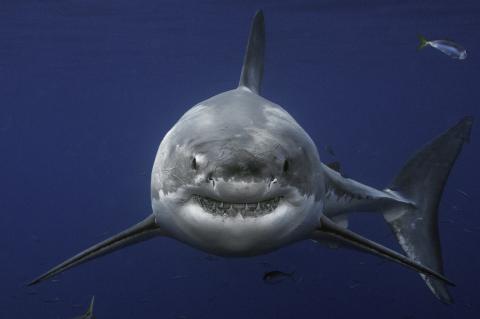 Shark Encounters Are on the Rise. Why?
Shark Encounters Are on the Rise. Why?A handful of recent shark attacks and sightings on Long Island's barrier beaches has beachgoers on edge and officials responding with red-flag beach warnings and enhanced shark patrols — but don't blame the sharks, said Greg Metzger of the South Fork Natural History Museum. They aren't here to feast on humans but on the vast schools of menhaden, or bunker, that have settled in for their annual summer residencies.
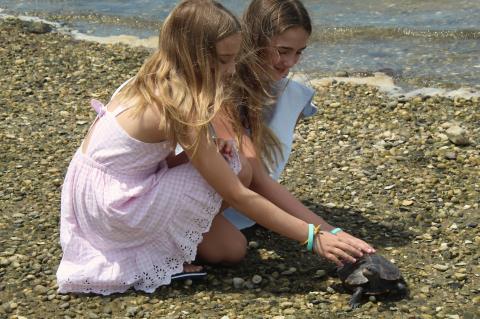 Lilly the Turtle Sets Out to Sea Four Years Later
Lilly the Turtle Sets Out to Sea Four Years LaterWhen young Ella and Gracie Wobensmith found the diamondback turtle on a Noyack Bay beach four years ago it, had serious wounds to its shell and a punctured lung. It was rehabilitated at a turtle rescue center, and this week the girls had a chance to help release it back into the wild.
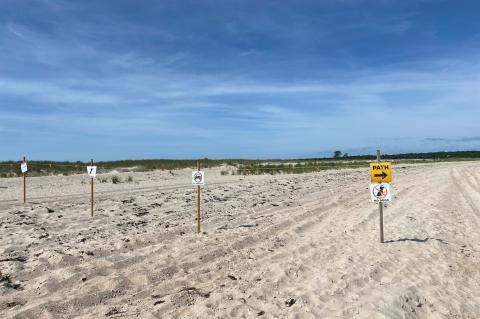 Piping Plover Nest Is Destroyed
Piping Plover Nest Is DestroyedPiping plover posts and fencing at Maidstone Park in Springs were ripped out of the ground on June 15, perhaps resulting in the deaths of two plover chicks that had recently hatched there.
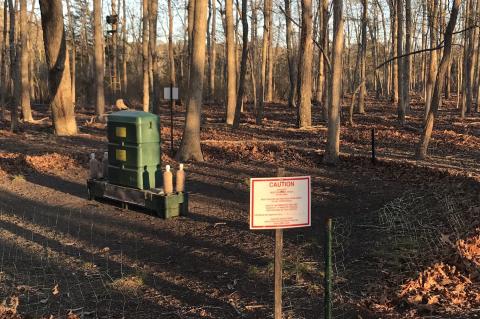 Targeting Ticks by Killing Them on Their Hosts
Targeting Ticks by Killing Them on Their HostsAt the end of March, in an ambitious effort to eradicate ticks on North Haven, the village relaunched its campaign to install "four-poster" feeding stations for deer. The stations bait deer with corn. While they feed, a tickicide is applied directly to their necks.
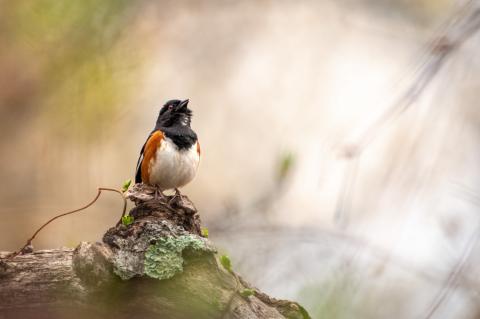 On the Wing: A Tempest of Towhees in a Teapot
On the Wing: A Tempest of Towhees in a TeapotThe eastern towhee breeds in Montauk, and if you go to Oyster Pond this weekend you can hear them calling and singing everywhere.
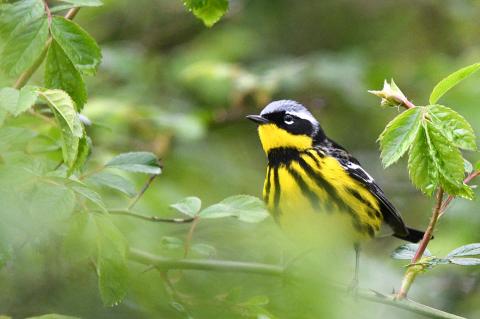 On the Wing: Millions of Birds on the Move
On the Wing: Millions of Birds on the MoveOver the next two weeks, spring bird migration will peak. Hundreds of millions of birds will fly up the country, largely south to north, in sync with blooming trees, flowers, and insect hatches. Many are attempting to reach the green attic of North America, the boreal forest of Canada, where they will breed and raise their young before reversing course in the autumn.
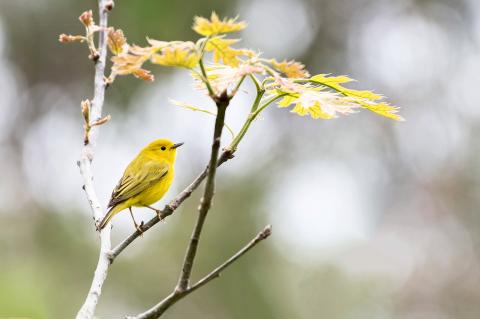 On the Wing: Think Like a Bird in Your Backyard
On the Wing: Think Like a Bird in Your BackyardTo make your backyard bird-friendly, you'll need to think like a bird when making landscaping decisions.
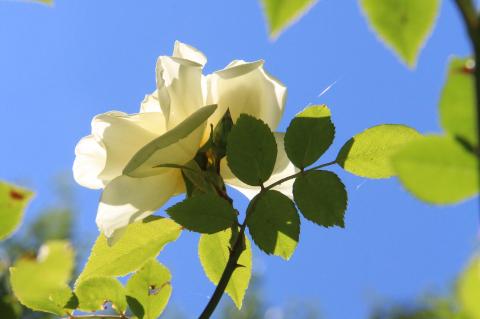 Stop and Smell the Roses
Stop and Smell the RosesIn the Northeastern United States, at least, these blossoms — whether red, pink, peach, yellow, white, or some combination of all — are at peak perfection starting in late May through June. As you stroll about, drive around town, or even take the train, here are some South Fork spots where you can find this favorite flower.
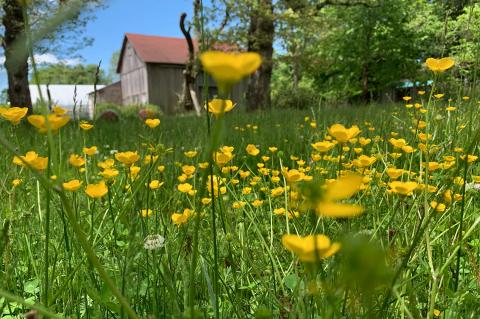 Abuzz About Pollinator Pathways
Abuzz About Pollinator PathwaysWhat are pollinator gardens and why are so many people talking about them right now? The idea, according to the organizers of the Pollinator Pathway movement, is to manage backyards without pesticides and with native plantings so they can connect with parks and preserves, creating a sort of bird and insect “refuge corridor,” an "archipelago" of habitats.
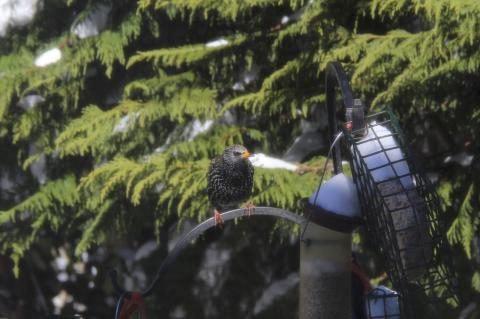 Great Backyard Bird Count Is This Weekend
Great Backyard Bird Count Is This WeekendThis weekend is the 25th anniversary of the Great Backyard Bird Count. To participate, you spend a minimum of 15 minutes counting birds, and afterward report what you see to the number-cracking scientists at the Cornell Lab of Ornithology.

